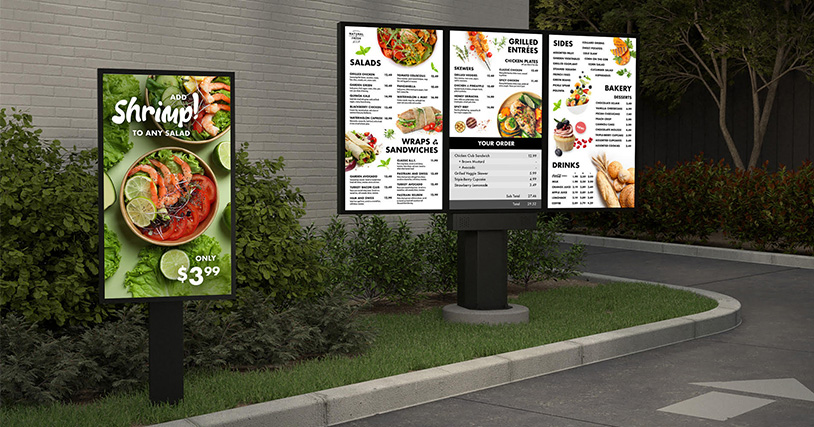
In today’s all digital culture, digital signage is an effective way for businesses with any amount of foot traffic to create a dynamic customer experience and boost employee engagement. Since consumers today prefer video to any other form of marketing, the most effective marketers will be those that harness the power of the digital screen to visually communicate, influence and inform the audience – and digital signage presents an ideal opportunity to connect with prospects and customers, as well as staff.
A “menu” – or simply a list of services – is a commonly used method for showcasing products, services, and prices across a variety of business, including restaurants, convenience stores, auto repair shops, gyms, hair salons, government offices, and more. Before the digital age, menu boards were always static – although creative companies would make them more enticing with chalk drawings, graphics and other visual techniques. However, because changes were made manually, they were often infrequent, leaving promotions and menus out of date. That’s not the case with digital signage. In fact, in addition to displaying and updating products and services in a way that is visually appealing and simple to comprehend, one of the many benefits of using digital menu boards is that you can keep them up-to-date easily – and in some cases, automatically. With some systems, all it takes is the click of a computer mouse to update one to one hundred (or more) displays.
Finding the Right Digital Signage Vendor
So how do you choose the digital signage system that’s right for your business? Here are six capabilities to consider as you evaluate digital signage providers:
- Anytime, anywhere updates: Whether you have one menu board in one location or five in each of 500 locations, having the ability to update content at any time and from anywhere is an important capability in a digital signage system. The ideal system is one in which the digital menu boards are networked for easy updates, but do not rely on a constant connection. The ability to receive, locally store, and playback content according to a schedule is “store and forward” capability that can be supported with connected players or commercial SmartTVs.
- Content management and scheduling: With a cloud-based content management system, you can connect to the signage system from any location and, using a web browser, make content updates, change schedules, and monitor the status of your digital menu boards. The scheduling function allows you to prepare content in advance and place time limits on how long it is displayed without worrying about last-minute or late-night updates – another great feature to have in your system.
- Real-time and site-specific content: A major benefit to the digital menu board is the ability to change the content displayed to align with site-specific needs and real-time inputs such as inventory levels, weather and community events. When supply chain issues cause price increases or stock shortages, you’ll want to be able to change your menu board accordingly from a central location.
- Multi-purpose signage: While digital signage is often considered through a customer-facing lens, it has major benefits for employees as well. Look for the ability to schedule employee information to display on the menu board before opening or after closing. Other features that you’ll want to have in your system include a dedicated employee-facing screen, or the ability to distribute training and development videos for timed on on-demand viewing.
- Integrations with other systems: Your menu boards don’t operate in a silo – consider whether your provider can integrate with existing or future HR systems, online review sites and online ordering systems. Even if you don’t use those integrations today, you’ll want the flexibility to add them in the future.
- Support services: Take stock of your internal resources and capabilities and what in-house services and staff might be available to you to support a digital signage system. Consider whether your provider offers installation, field maintenance, and other support service to keep your system up-to-date, online and content rich.
Digital signage is an excellent channel to help organizations communicate, influence and inform target audiences with dynamic and immersive content. Far from the static menu boards of the past, these video-rich, engaging displays can enhance customer marketing and employee communications programs– but not all signage providers offer the same features, so consider the flexibility, scalability and integration capabilities that will help meet your business needs.